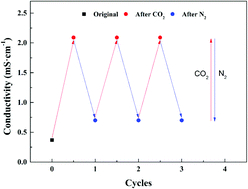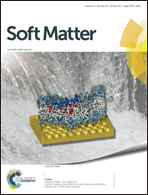CO2-Switchable microemulsion based on a pseudogemini surfactant†
Abstract
At present, more and more researchers around the world are paying attention to stimuli-responsive surfactants. In this paper, we have reported a microemulsion prepared from the tertiary amine TMPDA (N,N,N′,N′-tetramethyl-1,3-propanediamine) and the anionic surfactant SDS (sodium dodecyl sulphate), which has good carbon dioxide response characteristics. The molar ratio of TMPDA to SDS is 1 : 2. By introducing CO2 into the microemulsion that consists of SDS, TMPDA, n-hexane, n-butanol and water, the tertiary amine TMPDA molecules can be protonated to form quaternary ammonium species. The protonated tertiary amine TMPDA can be assembled with SDS by electrostatic interactions to form a pseudogemini surfactant (SDS–TMPDA–SDS). The pseudogemini surfactant can dissolve in the aqueous phase which makes the microemulsion break down eventually. By bubbling N2 after CO2 into the same system at 50 °C for 3 hours, the pseudogemini surfactant SDS–TMPDA–SDS disintegrates into SDS and TMPDA, respectively. At the same time, the microemulsion also recovers its initial state. Such a reversible transition could be repeated for several cycles from monophase to complete phase separation.



 Please wait while we load your content...
Please wait while we load your content...